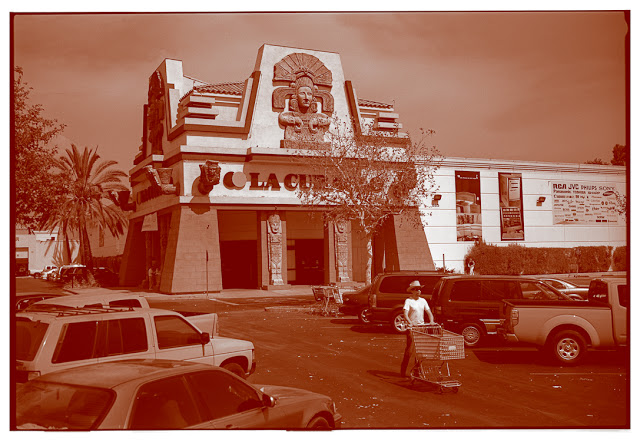
Jesse Lerner. Ruins, 1999. 16mm, in Spanish and English with English and Spanish subtitles; 78 mins. Courtesy of Light Industry.
For ten years I had the pleasure of living—really, the privilege of coming of age—in Los Angeles and Mexico City. I was born and raised in Mexico City (what used to be known as D.F., for Distrito Federal)—and I consider L.A. my other city with a two-letter name. In Los Angeles, I studied, published my first book, and became the person who I am, all the while staying in Mexico for long periods. Living in L.A. at the time were several Mexican artists or art world-related people who are now back in Mexico City or elsewhere: Yoshua Okón, with whom I shared part of my life; as well as Mario García Torres, Magalí Arriola, Eduardo Abaroa, Brett Schulz, Carla Herrera-Prats; not to mention the local Mexeleno fixtures Rubén Ortiz Torres, Milena Muzquiz, or Hugo Hopping; and Angexicans such as Jesse Lerner and Rita Gonzalez, among many others. When I moved back to Mexico City, others moved to L.A.: filmmakers, architects, curators, and other artists, like Gabriel Kuri or Yishai Jusidman; those who have initiated two-city endeavors, such as Fernando Mesta’s recent gallery opening in Macarthur Park; and many who have become expatriates. There have been historical exchanges between both cities, such as Magali Lara’s participation in the Woman’s Building and, further back in time, David Siqueiros’s painting Tropical America in downtown Los Angeles. Plus, there are the ongoing crosstransborder footsteps of Harry Gamboa, a core member of the Asco art collective, or those of writers like Daniel Hernández or Josh Kuhn, which retrace the contours of a possible version of Aztlán—the invisible thread that connects the two cities together and remains as fluid and flowing as ever.
It goes almost without saying that today both cities have their growing variety of artist-run spaces, many of which are in dialogue; their curators and gallery dealers who shuttle themselves back and forth on the short, four-hour flights; and their state-of-the-art museums (both cities claim to have more museums per capita than any other). Both have their internationally ranked blue-chip galleries, and one of the most important collectors in the continent has residences in both cities. Frankly, I find it tiresome to list the similarities between the two cities (yet to list the differences is pointless), starting with all of these commonplace statements, and ending with how one can find echoes of Skid Row or Beverly Hills just about anywhere in Mexico City, as well as finding handmade blue-corn tortillas, a hipster Angostura-bitters-enhanced cocktail, or Korean karaoke parlors in either place.

Image via Hub Pages.
More interestingly, both cities partake in the collective nightmare of earthquakes, pollution, and an “ecology of fear” (as Mike Davis famously called it), and although it is almost a cliché, both cities share traffic in terms of circulation and jams: the embodied experiences of both cities are uncannily similar. Their urban spreads are also alike; peaks surround and encase the air of both cities. And they both share an image that their art worlds are always up-and-coming: Mexico City’s emerging art scene has been announced since the early 2000s (such as with P.S.1’s exhibition, Mexico City: An Exhibition about the Exchange Rates of Bodies and Values), and it seems L.A. will forever be the second child to New York’s established scene. These are questionable pronouncements, at the least. But such allegations are nevertheless pervasive in the “international” art world, which asserts its capital primacy in cities like New York or London while fanning its perpetual desire for novelty to be found in up-and-coming (that is, marginal) biennials, cities, and collections. I am less interested in those labels, which sound more like marketing—for art magazines to sell more issues and for shows to sell more tickets—than in the actual generation, participation, study, and critique of an art scene.
If many artists moved to L.A. from the East Coast of the United States for cheaper rents, the same has happened in Mexico City, and foreign-fueled gentrification (plus the influence of Airbnb) has changed the city’s urban landscape in only a few years. But all is not market-driven, thankfully: people also went to L.A. to attend or teach at one of the twelve graduate art-school programs in and around the city—some of the best in the country—along with many Mexican artists. Similarly, people move to Mexico City to teach at graduate programs, to participate in a residency, or to show at one of the many galleries (or open a new one), and never leave. While I was in L.A., I felt that projects like Fritz Haeg’s Sundown Salon had a sense of kinship with spaces like Mexico City’s La Panadería, and that Art2102 was a kindred spirit with Temístocles22— though no clear and conscious link existed, things just wove themselves that way in my immigrant brain.

Rubén Ortiz Torres, Un Poco de su Pais (A Little of Your Country)
From The Past is not What it Used to Be. Image via The Reel Aztlán.
What I find most relevant is that the art scenes that have flourished in both places (regardless of irresponsible hype about how L.A. is like Berlin with surfboards or how Mexico City like the new Berlin with…whatever) are peripheral to the perceived great art capitals of the world. This condition allows for things to happen; it is the virtue of the minor, the marginal, the peripheral. Things are happening on the streets here (meaning both cities, as they compose one overlapping megalopolis in my psycho-geography) that no longer happen in other places. Things happen to the streets, even. Weirdly, the streets are one of the things that make me pine for Los Angeles. Driving around my neighborhood here, I find that some “Spanish-style” 1940s house there, or a palm tree here, looks exactly like it would there. Or perhaps it’s the other way around: in L.A., I found myself sighing for Mexico while looking at jacaranda-covered sidewalks. Either way, as Lawrence Weschler describes the city’s glow, “I love walking down the street when the light’s all reverberant, bouncing around like that, and everything’s just humming in your face.” And indeed I forever feel like an exiled local, as I hear both cities humming to their synched tunes, each with the weight of a uniquely altitude-d air.



